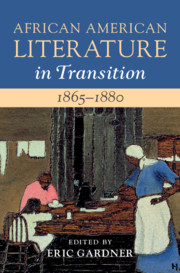Book contents
- African American Literature in Transition, 1865–1880
- African American Literature in Transition
- African American Literature in Transition, 1865–1880
- Copyright page
- Contents
- Figures
- Contributors
- Preface
- Chronology
- Black Reconstructions: Introduction
- Part I Citizenships, Textualities, and Domesticities
- Part II Persons and Bodies
- Chapter 5 Black Reform, Writing, and Resistance: Textual Politics in the Postwar Era
- Chapter 6 Post-Civil War Black Childhoods
- Chapter 7 Disabling Freedom: Bloody Shirt Rhetoric in Postbellum Slave Narratives
- Chapter 8 Radical Respectability and African American Women’s Reconstruction Fiction
- Part III Memories, Materialities, and Locations
- Index
Chapter 7 - Disabling Freedom: Bloody Shirt Rhetoric in Postbellum Slave Narratives
from Part II - Persons and Bodies
Published online by Cambridge University Press: 18 March 2021
- African American Literature in Transition, 1865–1880
- African American Literature in Transition
- African American Literature in Transition, 1865–1880
- Copyright page
- Contents
- Figures
- Contributors
- Preface
- Chronology
- Black Reconstructions: Introduction
- Part I Citizenships, Textualities, and Domesticities
- Part II Persons and Bodies
- Chapter 5 Black Reform, Writing, and Resistance: Textual Politics in the Postwar Era
- Chapter 6 Post-Civil War Black Childhoods
- Chapter 7 Disabling Freedom: Bloody Shirt Rhetoric in Postbellum Slave Narratives
- Chapter 8 Radical Respectability and African American Women’s Reconstruction Fiction
- Part III Memories, Materialities, and Locations
- Index
Summary
Keith Michael Green’s “Disabling Freedom: Bloody Shirt Rhetoric in Postbellum Slave Narratives” explores the mystifications and erasures of anti-Black violence that characterized Reconstruction-era writing.Green pays deep attention to how select narratives – especially the much-neglected Story of Mattie Jackson and Keckley’s better-known Behind the Scenes – strategically employed oblique narrativizations of Black pain and personhood to avoid pernicious narratives of Black unfitness and hyper-embodiment.Green draws on what he calls the “poetics of the bloody shirt” to study the ventriloquization of injury through surrogate objects and persons, with emphasis on not only Jackson and Keckley’s texts but also works by Sojourner Truth, Still, and William Wells Brown to underscore how indirect representations of injury helped postbellum slave narratives articulate the contradictions and risks of Black life and to revise ableist visions of freedom – in the process, contesting the erasure of Black pain in post-emancipation discourse.
Keywords
- Type
- Chapter
- Information
- African American Literature in Transition, 1865–1880Black Reconstructions, pp. 161 - 186Publisher: Cambridge University PressPrint publication year: 2021
- 1
- Cited by

